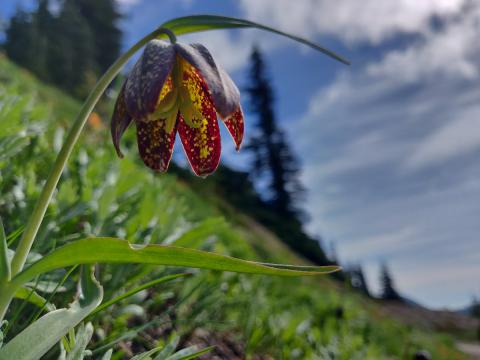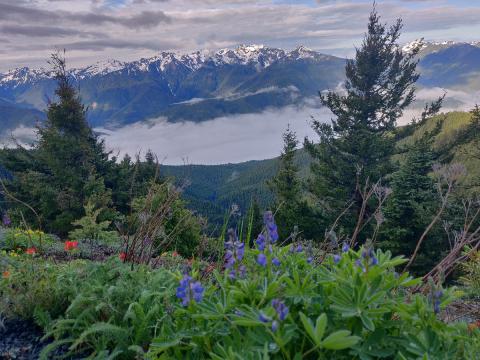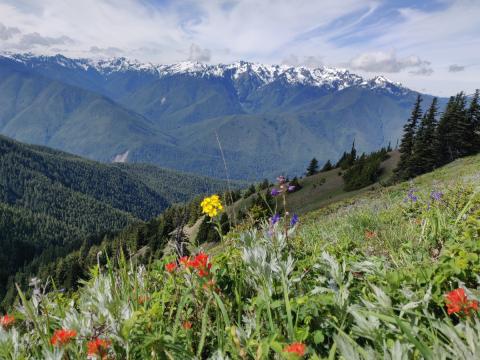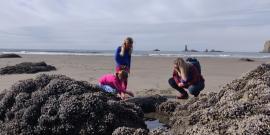
Bask in the Glory of Hurricane Ridge with Experience Olympic
Hurricane Ridge is a great sightseeing, hiking, and birding tour destination from May to October.
Private day tours to Hurricane Ridge can be scheduled as a half day guided sightseeing tour from Port Angeles. If you are interested in a full day guided hike, contact us about organizing a thru (one-way) guided hike using the new public bus shuttle.
Visiting Hurricane Ridge is best enjoyed with a guide who knows where the carnivorous plants grow and brings a spotting scope for viewing endemic Olympic Marmots.
Hurricane Ridge is the Pathway to Olympic's Sublime Subalpine
Discover panoramic views of the Olympic mountains, subalpine wildflowers, butterflies, birds, and mammals on Hurricane Ridge hiking and wildlife viewing tours with a biologist.
Your wildlife guide, Carolyn, conducted her field research on plants adapted to living in a desert environment while in graduate school. Plants and animals at Hurricane Ridge must endure similarly harsh environmental conditions throughout much of the year.
Port Angeles is the Gateway to Hurricane Ridge
The roughly forty five minute drive from Port Angeles to Hurricane Ridge is on a well maintained and paved road with ample pull outs.
The drive to Hurricane Ridge gives you access to stunning montane forests, tunnels through rock, basalt outcroppings, views of the Olympic Mountains, sparse old twisted conifers, and subalpine meadows.
On a clear day, a visit to Hurricane Ridge will hopefully allow us to view Mount Olympus, the highest peak in the Olympic Mountain range towering at just under 8,000 ft. (2400 m) elevation.
Most Accessible During the Summer Months
Hurricane Ridge offers the most accessible access to the high country in Olympic National Park from roughly Memorial Day to Labor Day and the hiking and sightseeing options are excellent.
Access to Hurricane Ridge is great during the summer but unpredictable the rest of the year. Usually Hurricane Ridge is open daily starting in May and ending in October. Hurricane Ridge is often closed in April and November and the winter season is usually from December to March, when Hurricane Ridge is only open Friday to Sunday if the weather is good and it is staffed.
Charismatic Groundhogs of Olympic National Park
The Olympic Marmot (Marmota olympus) is in the same genus as the lowland groundhog or woodchuck (Marmota monax), a species made famous by Groundhog Day. The Olympic Marmot is endemic, meaning that it is only found in the Olympic mountains and nowhere else.
Marmots are very social and we can usually start to observe them eating plants in May as the snow melts. They live in colonies and burrow underground. They can begin their hibernation as early as September.
Olympic Peninsula Isolation
During the last ice age, only certain areas on the Olympic Peninsula were free of ice, including Hurricane Ridge.
This geologic “island-effect” combined with the Olympic Peninsula being surrounded by water on three sides geographically, has resulted in isolation and the evolution of unique flora and fauna.
The Olympic Marmot is an example of unique fauna and Piper’s Bellflower is an example of unique flora of the Olympic Peninsula.
Additional Hurricane Ridge Mammals
In addition to Olympic Marmots, we can also view Olympic Chipmunk, Black-tailed Deer, Snowshoe Hare, and Black Bear.
Black Bear can be viewed at a distance in the greenest of subalpine meadows when leafy green plant growth is fresh and lush, usually in June.
A low snowpack and dry hot spring/summer can lead to some variable wildlife viewing conditions in late summer and early fall.
Hurricane Ridge Birds and Mammals active early in the morning
Sunrise can be as early as 5:13 AM on the summer solstice with twilight starting around 4:43 AM. The dawn chorus of songbirds (a phenomenon that occurs in the early morning hours during breeding) starts in early spring and continues until roughly mid July starts around twilight. It is best to organize tours up to Hurricane Ridge early in the morning to take advantage of the twilight hours.
In summer, timing is especially important because warmer temperatures are the perfect conditions for mid-day wildlife inactivity.
Hurricane Ridge Birds and Butterflies
Nature lovers flock to the Olympic Mountains in the summer and are known to concentrate on birds in the early morning when they are the most active and then switch to butterflies later in the day. Bird activity often drops off around noon when butterfly activity picks up.
Butterflies are insects and insects are comprised of the head, thorax, and abdomen. Butterfly thoracic temperatures must reach a certain minimum in order to take flight in the morning which is why you will see them basking in the sun with their wings spread but not flying around in the morning.
Wildflowers of Hurricane Ridge
Old Man's Whiskers or Prairie Smoke (Geum triflorum) is pictured here at the top of Hurricane Hill with the Olympic Mountains in the distance. A unique variety (campanulatum) has been described here in Olympic.
Some of the more interesting Olympic wildflowers like to grow not only in high elevation rocky crevices but also next to year-round flowing streams and boggy ephemeral wetlands.
By August, most of the these wildflowers have already bloomed in order to be able to disperse their seeds in time for winter when they will be covered in feet of snow.
Aftermath of the 2023 Day Lodge Fire
Very little nature interpretation is left from the 2023 fire that consumed the Hurricane Ridge Day Lodge, making a hiking and nature guide even more useful in understanding the complexities of the Hurricane Ridge ecosystem.
People have been enjoying Hurricane Ridge for thousands of years without a permanent structure like a lodge. Our visits Hurricane Ridge highlight the natural world: the sparse stands of stunted subalpine trees and tapestry of subalpine wildflowers as well as the views and wildlife.
Hurricane Ridge vs Mount Rainer's Paradise
Both Hurricane Ridge and Paradise in Mount Rainer National Park are at about 5000 feet elevation and share similar plants and wildlife.
Rainer is a volcano that climbs to 14,000 feet so Paradise has access to ample running water during the summer and fall. In contrast, once the snow disappears from Hurricane Ridge, there is not more access to running water.
Hurricane Ridge has much more reliable spring or early summer wildflowers, whereas Paradise is typically better for wildflowers starting in August.





